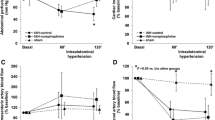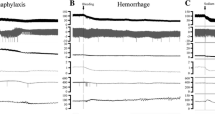Abstract
Multiorgan system failure due to hypotension and sepsis is an important cause of death in patients with bowel obstruction. We have investigated the pathophysiology of this entity in an animal model. After 5 days of bowel obstruction, blood flow in the superior mesenteric artery was measured with and without Pitressin and norepinephrine given in separate experiments. In controls, Pitressin in moderate dosages caused a substantial fall in gut blood flow, which was not seen in obstructed animals (blood flow reduction 52 percent vs. 11 percent in sham and obstructed animals respectively,P <0.01). Similarly, norepinephrine infusion had less of an effect on gut blood flow in obstructed animals (blood flow reduction 79 percent vs. 58 percent sham vs. obstructed animals (P < 0.05). Thus, both agents had dose-related effects on gut blood flow, which was maintained at a higher level throughout the drug infusion periods in the bowel of obstructed animals, demonstrating that splanchnic flow is less responsive to vasoactive drug infusion under these experimental conditions. Because splanchnic vasoconstriction is an important feature of normal hemodynamic homeostasis, we suggest that these results may help explain some aspects of the pathophysiology of multiorgan failure caused or worsened by systemic hypotension seen in bowel obstruction.
Similar content being viewed by others
References
Fielding LP, Wells BW. Survival after primary and after staged resection for large bowel obstruction cause by cancer. Br J Surg 1974;61:16–18.
Ohman U. Studies on small intestinal obstruction. III. Circulatory effects of artificial small bowel distension after obstruction. Acta Chir Scand 1975;141:536–44.
Umpleby HC, Williamson RC. Survival in acute obstructing colorectal carcinoma. Dis Colon Rectum 1984;27:299–304.
Irvin TT, Greaney MG. The treatment of colon cancer presenting with intestinal obstruction. Br J Surg 1977;64:741–4.
Phillips RK, Hittinger R, Fielding LP. Malignant large bowel obstruction. Br J Surg 1985;72:296–302.
Raf LE. Causes of small intestinal obstruction: a study covering the Stockholm area. Acta Chir Scand 1969;35:67–72.
Havia T, Scheinin TM. Intestinal obstruction. Ann Chir Gynecol Fenn 1969;58:219–23.
Feny OG. Diagnostic problems of acute abdominal diseases in the aged. Acta Chir Scand 1974;140:396–405.
Brooksby GA, Donald DE. Dynamic changes in splanchnic blood flow and blood volume in dogs during activation of sympathetic nerves. Circ Res 1971;29:227–38.
Chien S. Role of the sympathetic nervous system in hemorrhage. Physiol Rev 1967;47:214–88.
Greenway CV. Role of splanchnic venous system in overall cardiovascular homeostasis. Fed Proc 1983;42:1678–84.
Greenway CV, Lister GE. Capacitance effects and blood reservoir function in the splanchnic vascular bed during nonhypotensive haemorrhage and blood volume expansion in anaesthetized cats. J Physiol 1974;237:279–94.
Price HL, Deutsch S, Marshall BE, Stephen GW, Behar MG, Neufeld GR. Hemodynamic and metabolic effects of hemorrhage in man, with particular reference to the splanchnic circulation. Circ Res 1966;18:469–74.
Rothe CF. Control of capacitance vessels. In: Shepherd AP, Granger DN, eds. Physiology of the intestinal circulation. New York: Raven Press, 1984.
Enochsson L, Nylander G, Ohman U. Effects of intraluminal pressure on regional blood flow in obstructed and unobstructed small intestines in the rat. Am J Surg 1982;144:558–61.
Nikas D, Ahn Y, Fielding LP. Sensitivity of colon blood flow to changing hemodynamics events. Curr Surg 1985;42:20–3.
Papanicolaou G, Nikas D, Ahn Y, Condos S, Fielding LP. Regional blood flow and water content of the obstructed small intestine. Arch Surg 1985;120:926–32.
Papanicolaou G, Ahn Y, Nikas DJ, Fielding LP. Effect of large-bowel obstruction on colonic blood flow: an experimental study. Dis Colon Rectum 1989;32:673–9.
Ganz W, Swan HJC. Measurement of blood flow by thermodilution. Am J Cardiol 1972;29:241–6.
Siegel S. Nonparametric statistics for the behavioral sciences. New York: McGraw-Hill, 1956.
Gatch WD, Culbertson CG. Circulatory disturbances caused by intestinal obstruction. Ann Surg 1935;102:619–35.
Lawson H, Chumley J. The effect of distension on blood flow through the intestine. Am J Physiol 1940;131:368–77.
Noer RJ, Derr JW. Effect of distension on intestinal revascularization. Arch Surg 1949;59:542–9.
Noer RJ, Robb HS, Jacobsen LF. Circulatory disturbances produced by acute intestinal distension in the living animal. Arch Surg 1951;63:520–8.
Oppenheimer MJ, Mann FC. Intestinal capillary circulation during distention. Surgery 1943;13:548–54.
Dragstedt CA, Lang VF, Millet RF. The relative effects of distension on different portions of the intestine. Arch Surg 1929;18:2257–63.
Boley SJ, Agrawal GP, Warren AR,et al. Pathophysiologic effects of bowel distention on intestinal blood flow. Am J Surg 1969;117:228–34.
Hanson KM, Moore FT. Pressure-volume relationships and blood flow in the distended colon. Am J Physiol 1969;217:35–9.
Wangensteen OH. Intestinal obstruction. 3rd ed. Springfield, IL: Charles C Thomas, 1955.
Ohman U. Studies on small intestinal obstruction. III. Circulatory effects of artificial small bowel distension after obstruction. Acta Chir Scand 1975;141:536–44.
Ohman U. Studies on small intestinal obstruction. IV. Circulatory effects of artificial small bowel distension after obstruction. Acta Chir Scand 1975;141:545–9.
Ruf W, Suehiro G, Suehiro A, McNamara JJ. Small intestinal blood flow after 48 hours ileus, Prostigmin, and manual decompression. Z Exp Z Chirurg 1980;13:267–73.
Coxon JE, Dickson C, Taylor I. Changes in intestinal blood flow during the development of chronic large bowel obstruction. Br J Surg 1984;71:795–8.
Ruf W, Suehiro GT, Suehiro A, Pressier V, McNamara JJ. Intestinal blood flow at various intraluminal pressures in the piglet with closed abdomen. Ann Surg 1980;191:157–63.
Ferguson MK, Seifert FC, Replogle RL. The effects of thermal injury on rat skeletal muscle microcirculation. J Trauma 1982;22:880–3.
Aulick LH, Wilmore DW, Mason AD, Pruitt BA. Depressed reflex vasomotor control of the burn wound. Cardiovasc Res 1982;16:113–9.
Krogh A. The regulation of the supply of blood to the right heart. Scand Arch Physiol 1912;27:227–48.
Rowell LB. Human cardiovascular adjustments to exercise and thermal stress. Physiol Rev 1974;54:75–159.
Rowell LB. Cardiovascular adjustments to thermal stress. In: Shepherd JT, Abboud FM, eds. Handbook of physiology: peripheral circulation and organ blood flow. Bethesda: American Physiological Society (In press).
Lacroix E, Leusen I. Splanchnic and general hemodynamics after acute hemorrhage in the anesthetized dog. Arch Intern Physiol Biochem 1967;75:12–26.
Price HL, Deutsch S, Marshall BE, Stephen GW, Behar MG, Neufeld GR. Hemodynamic and metabolic effects of hemorrhage in man, with particular reference to splanchnic circulation. Circ Res 1966;18:469–74.
Reynell PC, Marks PA, Chidsey C, Bradley SE. Changes in splanchnic blood volume and splanchnic blood flow in dogs after haemorrhage. Clin Sci 1955;14:407–19.
Capderou A, Polianski J, Mensch-Dechene J,et al. Splanchnic blood flow, O2 consumption, removal of lactate, and output of flucose in highlanders. J Appl Physiol 1977;43:204–10.
Korner PI, Chalmers JP, White SW. Some mechanisms of reflex control of the circulation by the sympatho-adrenal system. Circ Res (Suppl) 1967;20,21(II):157–72.
Ramsoe K, Jarnum S, Preisig R, Tauber T, Tygstrup N, Westergaard H. Liver function and blood flow at high altitude. J Appl Physiol 1970;28:725–7.
Author information
Authors and Affiliations
Additional information
Supported by a grant from St. Mary's Hospital, 56 Franklin Street, Waterbury, Connecticut.
About this article
Cite this article
Neville, R., Fielding, L.P., Cambria, R.P. et al. Vascular responsiveness in obstructed gut. Dis Colon Rectum 34, 229–235 (1991). https://doi.org/10.1007/BF02090162
Issue Date:
DOI: https://doi.org/10.1007/BF02090162




